switch FIAT FULLBACK 2017 Owner handbook (in English)
[x] Cancel search | Manufacturer: FIAT, Model Year: 2017, Model line: FULLBACK, Model: FIAT FULLBACK 2017Pages: 312, PDF Size: 12.31 MB
Page 264 of 312
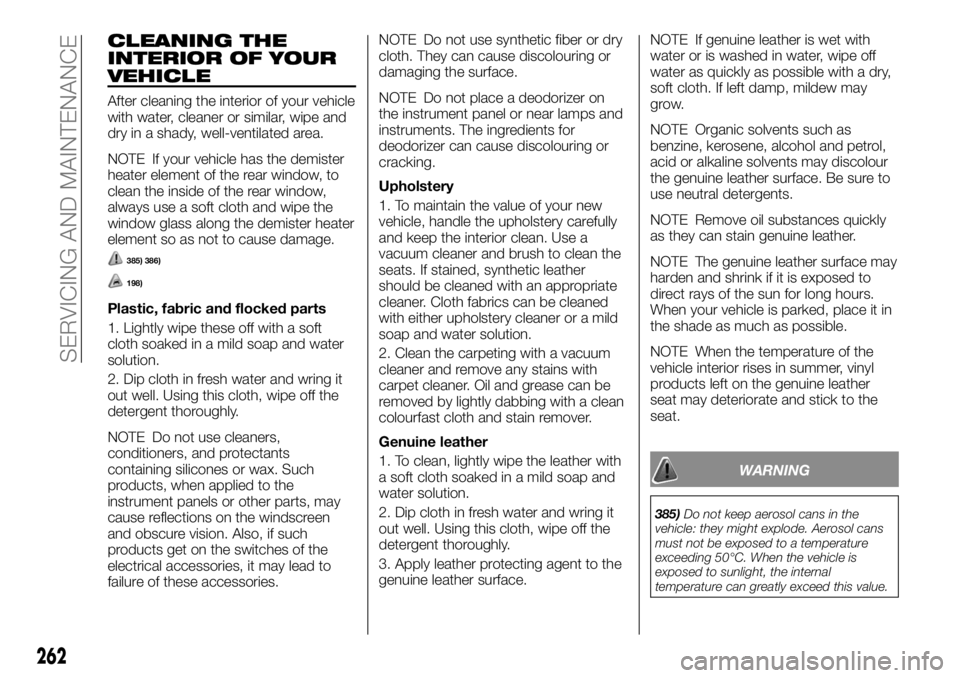
CLEANING THE
INTERIOR OF YOUR
VEHICLE
After cleaning the interior of your vehicle
with water, cleaner or similar, wipe and
dry in a shady, well-ventilated area.
NOTE If your vehicle has the demister
heater element of the rear window, to
clean the inside of the rear window,
always use a soft cloth and wipe the
window glass along the demister heater
element so as not to cause damage.
385) 386)
198)
Plastic, fabric and flocked parts
1. Lightly wipe these off with a soft
cloth soaked in a mild soap and water
solution.
2. Dip cloth in fresh water and wring it
out well. Using this cloth, wipe off the
detergent thoroughly.
NOTE Do not use cleaners,
conditioners, and protectants
containing silicones or wax. Such
products, when applied to the
instrument panels or other parts, may
cause reflections on the windscreen
and obscure vision. Also, if such
products get on the switches of the
electrical accessories, it may lead to
failure of these accessories.NOTE Do not use synthetic fiber or dry
cloth. They can cause discolouring or
damaging the surface.
NOTE Do not place a deodorizer on
the instrument panel or near lamps and
instruments. The ingredients for
deodorizer can cause discolouring or
cracking.
Upholstery
1. To maintain the value of your new
vehicle, handle the upholstery carefully
and keep the interior clean. Use a
vacuum cleaner and brush to clean the
seats. If stained, synthetic leather
should be cleaned with an appropriate
cleaner. Cloth fabrics can be cleaned
with either upholstery cleaner or a mild
soap and water solution.
2. Clean the carpeting with a vacuum
cleaner and remove any stains with
carpet cleaner. Oil and grease can be
removed by lightly dabbing with a clean
colourfast cloth and stain remover.
Genuine leather
1. To clean, lightly wipe the leather with
a soft cloth soaked in a mild soap and
water solution.
2. Dip cloth in fresh water and wring it
out well. Using this cloth, wipe off the
detergent thoroughly.
3. Apply leather protecting agent to the
genuine leather surface.NOTE If genuine leather is wet with
water or is washed in water, wipe off
water as quickly as possible with a dry,
soft cloth. If left damp, mildew may
grow.
NOTE Organic solvents such as
benzine, kerosene, alcohol and petrol,
acid or alkaline solvents may discolour
the genuine leather surface. Be sure to
use neutral detergents.
NOTE Remove oil substances quickly
as they can stain genuine leather.
NOTE The genuine leather surface may
harden and shrink if it is exposed to
direct rays of the sun for long hours.
When your vehicle is parked, place it in
the shade as much as possible.
NOTE When the temperature of the
vehicle interior rises in summer, vinyl
products left on the genuine leather
seat may deteriorate and stick to the
seat.
WARNING
385)Do not keep aerosol cans in the
vehicle: they might explode. Aerosol cans
must not be exposed to a temperature
exceeding 50°C. When the vehicle is
exposed to sunlight, the internal
temperature can greatly exceed this value.
262
SERVICING AND MAINTENANCE
Page 267 of 312
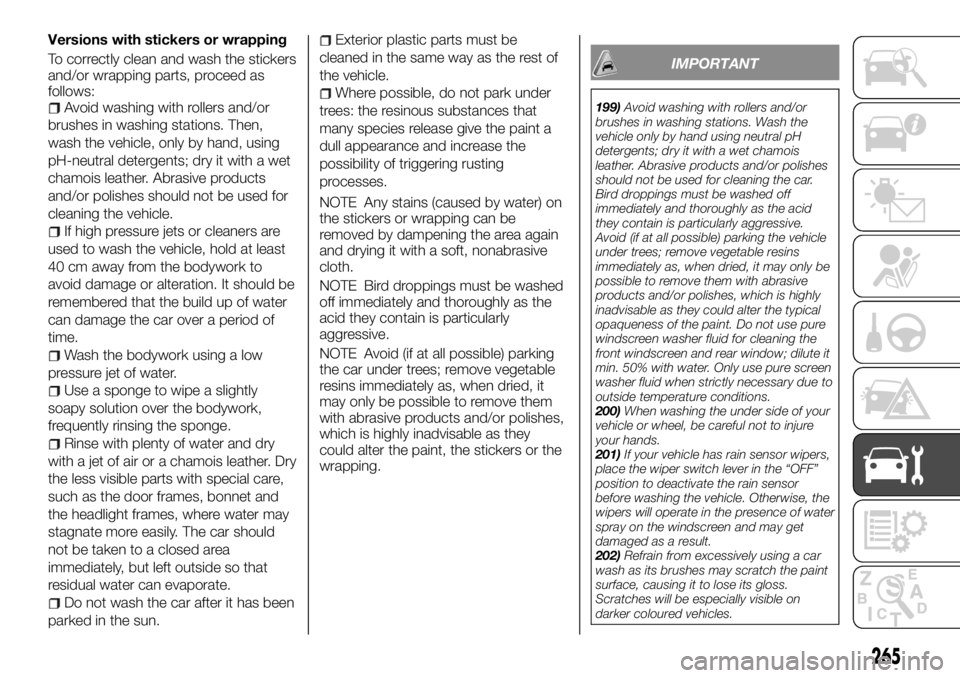
Versions with stickers or wrapping
To correctly clean and wash the stickers
and/or wrapping parts, proceed as
follows:
Avoid washing with rollers and/or
brushes in washing stations. Then,
wash the vehicle, only by hand, using
pH-neutral detergents; dry it with a wet
chamois leather. Abrasive products
and/or polishes should not be used for
cleaning the vehicle.
If high pressure jets or cleaners are
used to wash the vehicle, hold at least
40 cm away from the bodywork to
avoid damage or alteration. It should be
remembered that the build up of water
can damage the car over a period of
time.
Wash the bodywork using a low
pressure jet of water.
Use a sponge to wipe a slightly
soapy solution over the bodywork,
frequently rinsing the sponge.
Rinse with plenty of water and dry
with a jet of air or a chamois leather. Dry
the less visible parts with special care,
such as the door frames, bonnet and
the headlight frames, where water may
stagnate more easily. The car should
not be taken to a closed area
immediately, but left outside so that
residual water can evaporate.
Do not wash the car after it has been
parked in the sun.
Exterior plastic parts must be
cleaned in the same way as the rest of
the vehicle.
Where possible, do not park under
trees: the resinous substances that
many species release give the paint a
dull appearance and increase the
possibility of triggering rusting
processes.
NOTE Any stains (caused by water) on
the stickers or wrapping can be
removed by dampening the area again
and drying it with a soft, nonabrasive
cloth.
NOTE Bird droppings must be washed
off immediately and thoroughly as the
acid they contain is particularly
aggressive.
NOTE Avoid (if at all possible) parking
the car under trees; remove vegetable
resins immediately as, when dried, it
may only be possible to remove them
with abrasive products and/or polishes,
which is highly inadvisable as they
could alter the paint, the stickers or the
wrapping.
IMPORTANT
199)Avoid washing with rollers and/or
brushes in washing stations. Wash the
vehicle only by hand using neutral pH
detergents; dry it with a wet chamois
leather. Abrasive products and/or polishes
should not be used for cleaning the car.
Bird droppings must be washed off
immediately and thoroughly as the acid
they contain is particularly aggressive.
Avoid (if at all possible) parking the vehicle
under trees; remove vegetable resins
immediately as, when dried, it may only be
possible to remove them with abrasive
products and/or polishes, which is highly
inadvisable as they could alter the typical
opaqueness of the paint. Do not use pure
windscreen washer fluid for cleaning the
front windscreen and rear window; dilute it
min. 50% with water. Only use pure screen
washer fluid when strictly necessary due to
outside temperature conditions.
200)When washing the under side of your
vehicle or wheel, be careful not to injure
your hands.
201)If your vehicle has rain sensor wipers,
place the wiper switch lever in the “OFF”
position to deactivate the rain sensor
before washing the vehicle. Otherwise, the
wipers will operate in the presence of water
spray on the windscreen and may get
damaged as a result.
202)Refrain from excessively using a car
wash as its brushes may scratch the paint
surface, causing it to lose its gloss.
Scratches will be especially visible on
darker coloured vehicles.
265
Page 268 of 312
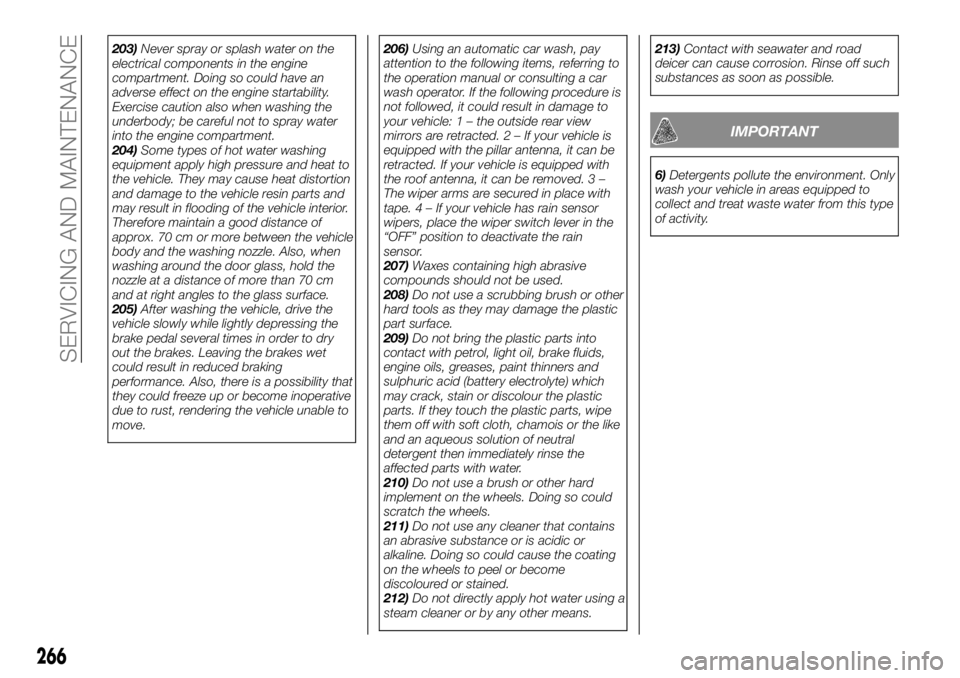
203)Never spray or splash water on the
electrical components in the engine
compartment. Doing so could have an
adverse effect on the engine startability.
Exercise caution also when washing the
underbody; be careful not to spray water
into the engine compartment.
204)Some types of hot water washing
equipment apply high pressure and heat to
the vehicle. They may cause heat distortion
and damage to the vehicle resin parts and
may result in flooding of the vehicle interior.
Therefore maintain a good distance of
approx. 70 cm or more between the vehicle
body and the washing nozzle. Also, when
washing around the door glass, hold the
nozzle at a distance of more than 70 cm
and at right angles to the glass surface.
205)After washing the vehicle, drive the
vehicle slowly while lightly depressing the
brake pedal several times in order to dry
out the brakes. Leaving the brakes wet
could result in reduced braking
performance. Also, there is a possibility that
they could freeze up or become inoperative
due to rust, rendering the vehicle unable to
move.206)Using an automatic car wash, pay
attention to the following items, referring to
the operation manual or consulting a car
wash operator. If the following procedure is
not followed, it could result in damage to
your vehicle: 1 – the outside rear view
mirrors are retracted.2–Ifyour vehicle is
equipped with the pillar antenna, it can be
retracted. If your vehicle is equipped with
the roof antenna, it can be removed. 3 –
The wiper arms are secured in place with
tape.4–Ifyour vehicle has rain sensor
wipers, place the wiper switch lever in the
“OFF” position to deactivate the rain
sensor.
207)Waxes containing high abrasive
compounds should not be used.
208)Do not use a scrubbing brush or other
hard tools as they may damage the plastic
part surface.
209)Do not bring the plastic parts into
contact with petrol, light oil, brake fluids,
engine oils, greases, paint thinners and
sulphuric acid (battery electrolyte) which
may crack, stain or discolour the plastic
parts. If they touch the plastic parts, wipe
them off with soft cloth, chamois or the like
and an aqueous solution of neutral
detergent then immediately rinse the
affected parts with water.
210)Do not use a brush or other hard
implement on the wheels. Doing so could
scratch the wheels.
211)Do not use any cleaner that contains
an abrasive substance or is acidic or
alkaline. Doing so could cause the coating
on the wheels to peel or become
discoloured or stained.
212)Do not directly apply hot water using a
steam cleaner or by any other means.213)Contact with seawater and road
deicer can cause corrosion. Rinse off such
substances as soon as possible.
IMPORTANT
6)Detergents pollute the environment. Only
wash your vehicle in areas equipped to
collect and treat waste water from this type
of activity.
266
SERVICING AND MAINTENANCE
Page 272 of 312
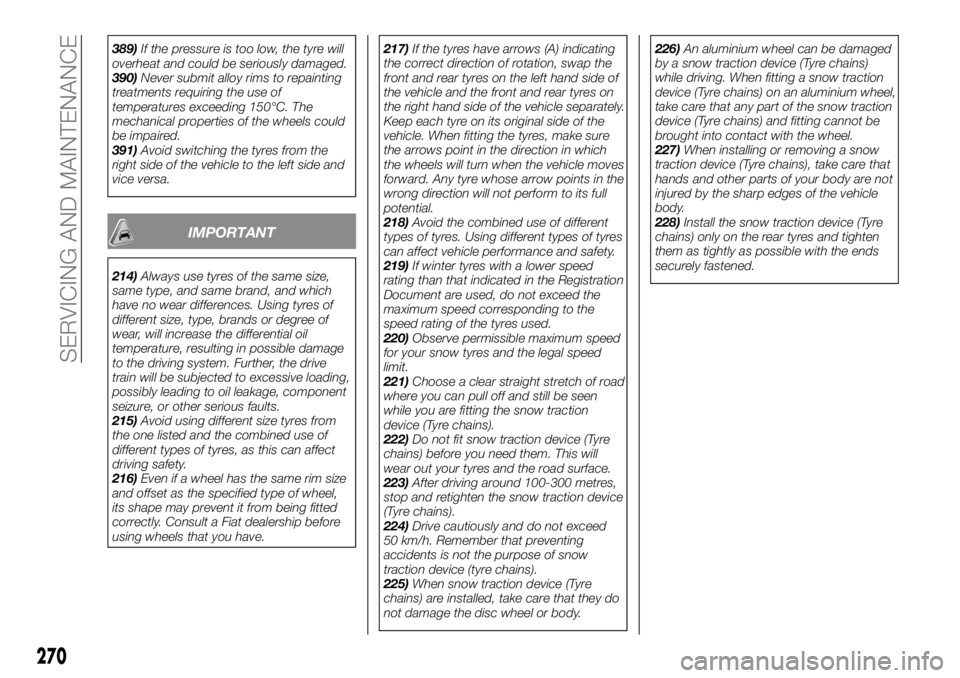
389)If the pressure is too low, the tyre will
overheat and could be seriously damaged.
390)Never submit alloy rims to repainting
treatments requiring the use of
temperatures exceeding 150°C. The
mechanical properties of the wheels could
be impaired.
391)Avoid switching the tyres from the
right side of the vehicle to the left side and
vice versa.
IMPORTANT
214)Always use tyres of the same size,
same type, and same brand, and which
have no wear differences. Using tyres of
different size, type, brands or degree of
wear, will increase the differential oil
temperature, resulting in possible damage
to the driving system. Further, the drive
train will be subjected to excessive loading,
possibly leading to oil leakage, component
seizure, or other serious faults.
215)Avoid using different size tyres from
the one listed and the combined use of
different types of tyres, as this can affect
driving safety.
216)Even if a wheel has the same rim size
and offset as the specified type of wheel,
its shape may prevent it from being fitted
correctly. Consult a Fiat dealership before
using wheels that you have.217)If the tyres have arrows (A) indicating
the correct direction of rotation, swap the
front and rear tyres on the left hand side of
the vehicle and the front and rear tyres on
the right hand side of the vehicle separately.
Keep each tyre on its original side of the
vehicle. When fitting the tyres, make sure
the arrows point in the direction in which
the wheels will turn when the vehicle moves
forward. Any tyre whose arrow points in the
wrong direction will not perform to its full
potential.
218)Avoid the combined use of different
types of tyres. Using different types of tyres
can affect vehicle performance and safety.
219)If winter tyres with a lower speed
rating than that indicated in the Registration
Document are used, do not exceed the
maximum speed corresponding to the
speed rating of the tyres used.
220)Observe permissible maximum speed
for your snow tyres and the legal speed
limit.
221)Choose a clear straight stretch of road
where you can pull off and still be seen
while you are fitting the snow traction
device (Tyre chains).
222)Do not fit snow traction device (Tyre
chains) before you need them. This will
wear out your tyres and the road surface.
223)After driving around 100-300 metres,
stop and retighten the snow traction device
(Tyre chains).
224)Drive cautiously and do not exceed
50 km/h. Remember that preventing
accidents is not the purpose of snow
traction device (tyre chains).
225)When snow traction device (Tyre
chains) are installed, take care that they do
not damage the disc wheel or body.226)An aluminium wheel can be damaged
by a snow traction device (Tyre chains)
while driving. When fitting a snow traction
device (Tyre chains) on an aluminium wheel,
take care that any part of the snow traction
device (Tyre chains) and fitting cannot be
brought into contact with the wheel.
227)When installing or removing a snow
traction device (Tyre chains), take care that
hands and other parts of your body are not
injured by the sharp edges of the vehicle
body.
228)Install the snow traction device (Tyre
chains) only on the rear tyres and tighten
them as tightly as possible with the ends
securely fastened.
270
SERVICING AND MAINTENANCE
Page 309 of 312
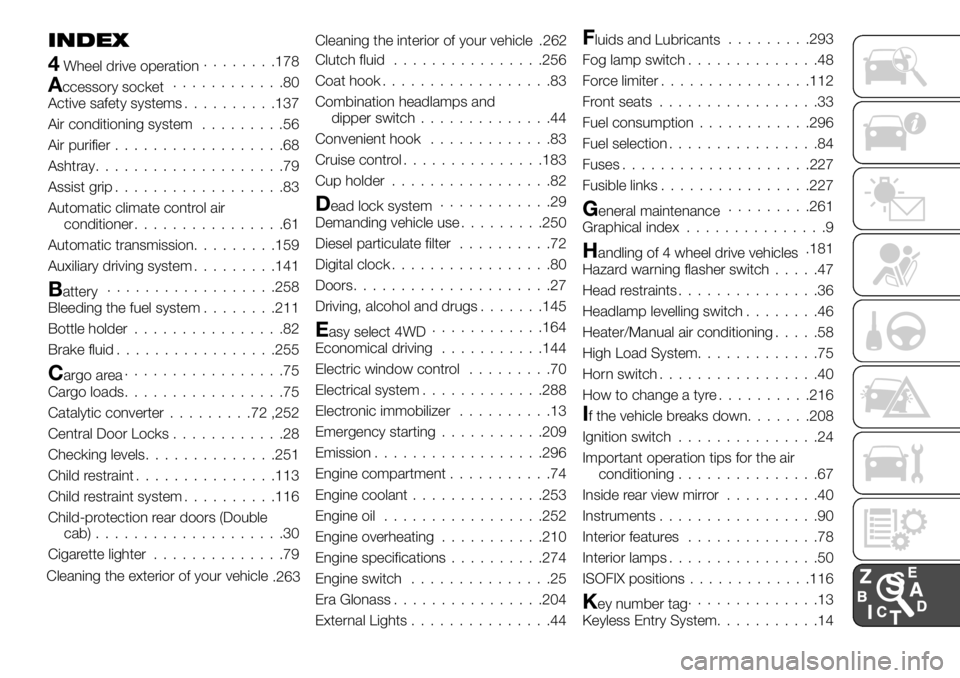
INDEX
4Wheel drive operation........178
Accessory socket............80
Active safety systems..........137
Air conditioning system.........56
Air purifier..................68
Ashtray....................79
Assist grip..................83
Automatic climate control air
conditioner................61
Automatic transmission.........159
Auxiliary driving system.........141
Battery..................258
Bleeding the fuel system........211
Bottle holder................82
Brake fluid.................255
Cargo area.................75
Cargo loads.................75
Catalytic converter.........72,252
Central Door Locks............28
Checking levels..............251
Child restraint...............113
Child restraint system..........116
Child-protection rear doors (Double
cab)....................30
Cigarette lighter..............79
Cleaning the exterior of your vehicle
.263Cleaning the interior of your vehicle .262
Clutch fluid................256
Coat hook..................83
Combination headlamps and
dipper switch..............44
Convenient hook.............83
Cruise control...............183
Cup holder.................82
Dead lock system............29
Demanding vehicle use.........250
Diesel particulate filter..........72
Digital clock.................80
Doors.....................27
Driving, alcohol and drugs.......145
Easy select 4WD............164
Economical driving...........144
Electric window control.........70
Electrical system.............288
Electronic immobilizer..........13
Emergency starting...........209
Emission..................296
Engine compartment...........74
Engine coolant..............253
Engine oil.................252
Engine overheating...........210
Engine specifications..........274
Engine switch...............25
Era Glonass................204
External Lights...............44
Fluids and Lubricants.........293
Fog lamp switch..............48
Force limiter................112
Front seats.................33
Fuel consumption............296
Fuel selection................84
Fuses....................227
Fusible links................227
General maintenance.........261
Graphical index...............9
Handling of 4 wheel drive vehicles.181
Hazard warning flasher switch.....47
Head restraints...............36
Headlamp levelling switch........46
Heater/Manual air conditioning.....58
High Load System.............75
Horn switch.................40
How to change a tyre..........216
If the vehicle breaks down.......208
Ignition switch...............24
Important operation tips for the air
conditioning...............67
Inside rear view mirror..........40
Instruments.................90
Interior features..............78
Interior lamps................50
ISOFIX positions.............116
Key number tag..............13
Keyless Entry System...........14
Page 310 of 312
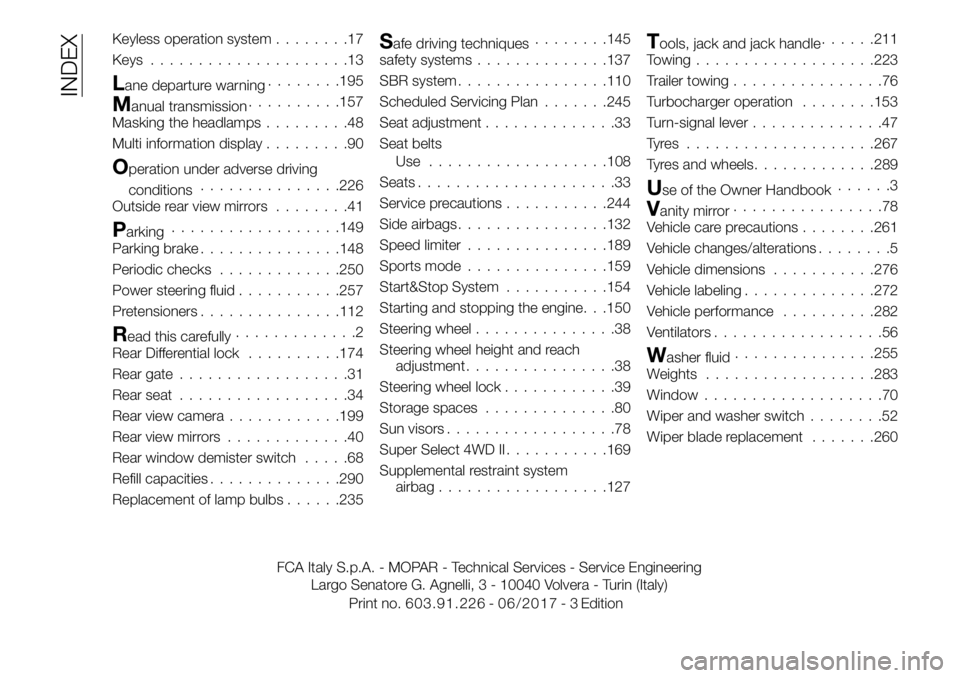
Keyless operation system........17
Keys.....................13
Lane departure warning........195
Manual transmission..........157
Masking the headlamps.........48
Multi information display.........90
Operation under adverse driving
conditions...............226
Outside rear view mirrors........41
Parking..................149
Parking brake...............148
Periodic checks.............250
Power steering fluid...........257
Pretensioners...............112
Read this carefully.............2
Rear Differential lock..........174
Rear gate..................31
Rear seat..................34
Rear view camera............199
Rear view mirrors.............40
Rear window demister switch.....68
Refill capacities..............290
Replacement of lamp bulbs......235
Safe driving techniques........145
safety systems..............137
SBR system................110
Scheduled Servicing Plan.......245
Seat adjustment..............33
Seat belts
Use ...................108
Seats.....................33
Service precautions...........244
Side airbags................132
Speed limiter...............189
Sports mode...............159
Start&Stop System...........154
Starting and stopping the engine. . .150
Steering wheel...............38
Steering wheel height and reach
adjustment................38
Steering wheel lock............39
Storage spaces..............80
Sun visors..................78
Super Select 4WD II...........169
Supplemental restraint system
airbag..................127Tools, jack and jack handle......211
Towing...................223
Trailer towing................76
Turbocharger operation........153
Turn-signal lever..............47
Tyres ....................267
Tyres and wheels.............289
Use of the Owner Handbook......3
Vanity mirror................78
Vehicle care precautions........261
Vehicle changes/alterations........5
Vehicle dimensions...........276
Vehicle labeling..............272
Vehicle performance..........282
Ventilators..................56
Washer fluid...............255
Weights..................283
Window...................70
Wiper and washer switch........52
Wiper blade replacement.......260
FCA Italy S.p.A. - MOPAR - Technical Services - Service Engineering
Largo Senatore G. Agnelli, 3 - 10040 Volvera - Turin (Italy)
INDEX
Print no.603.91.226 - -Edition 0 2017 /3 6